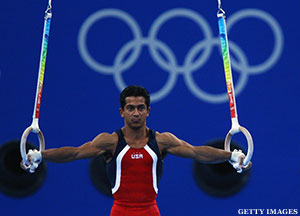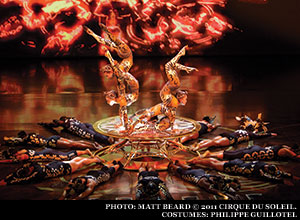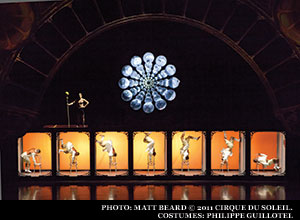
Imagine a job description that reads:
-- Dynamic company seeks energetic individuals accustomed to high pressure environment.
-- Must be able to adapt.
-- Must be flexible ... literally.
-- Minimum four years flying experience ... (and we're not talking about on an airplane).
You might think it would return very few applicants, but in the fantastical world of Cirque du Soleil, the opposite is true. Their sign might as well read "NOW HIRING: Positions include upside-down, one-armed handstand and twisted in a pretzel." It's a company, and a show, unlike any other.

And that's exactly where someone like Raj Bhavsar might choose to send his resume, one filled with prior experiences most human resource directors do not typically come across. For you see, 31-year-old Raj is a two-Olympic gymnast earning a bronze medal at the 2008 Olympic Games in Beijing.
After spending his post-Olympic career doing gymnastics clinics, speeches, some coaching and some marketing, he came to the realization. "I had this constant urge to be physical," he says backstage at his new office, the Kodak Theatre in Los Angeles. It's where he finds his urges satiated by his exciting new vocation as part of the newest Cirque creation "Iris" (pronounced "Ee-REECE" due to its French-Canadian beginnings).
"A number of our acrobats were gymnasts in a former life," says Leticia Buckley, the show's marketing and public relations manager. "Our 'Buster' [the lead played by Raphael Cruz] is a skater. And lots of different performers come from clown school. It does run the gamut."
This includes world champion acrobat Anna Kachalova, who had been on the radar of Cirque du Soleil for years, when she decided to move on from acrobatic competitions. After a few months in her hometown of Moscow, reveling in a more sedentary lifestyle, she was called in for a visit. "It wasn't really an audition," the 23-year-old recalls. "I just needed to show them what shape I was in, how I looked; if I'd lost anything over the past six months." Two months later, she was hired.

They are just a small part of what the show's artistic director Denise Biggi calls "the most incredible cast, not only acrobatically, but they are amazing human beings." This particular cast puts their skills to work in acts utilizing apparati ranging from the bungee trapeze to teeterboards and straps, among others.
But applying their previous expertise to the current task at hand isn't always a seamless transition. Raj was asked to go from the pommel horse, rings and parallel bars to a new trade -- trampolinist.
"The skills are different, apparatus is completely different," he explains. “What we rely more on are our abilities as a gymnast to carry over to a new apparatus or a new skill. That’s actually what I enjoy about it is knowing that I come from a background that allows me to do something like this."
Along with training for their new roles, some of the previously individual performers now must quickly embrace the team environment. "Me, as a flyer, I just have to trust my partners and they have to do most of the job. I just have to stay still,” Anna says modestly, then reconsiders. "Sometimes it's hard to do." (Having never been swung like the pirate ship at a theme park before, I can only guess that's an understatement.)
Even before the curtain rises, you can sense something magical in the air. Billed as "an incredible poetic journey through the world of cinema,” most patrons are blown away by the show. (The word "wow" is mumbled involuntarily by patrons throughout the evening.) And though the production may have all the makings of the theater, from the ushers to the outrageous costumes to the live orchestra, don't be fooled. Those entertaining you come from a different culture -- that of world-class athletics.
Acknowledging stark differences between her athletic career and her new avenue, Anna explains how she still uses the strengths that brought her there. "When you are in a competition, you're giving it all your soul and all you get are numbers and a little thing hanging on your neck afterwards, but to an audience, you're still giving everything, only you’re receiving so much energy after it," she says. "It makes you feel appreciated by them, not just by the judges. It's such a good feeling just to see people smiling at you."
Raj agrees, saying: "It's not about myself anymore. During gymnastics competitions, you're putting on a show for the people that were there, but you're also getting a lot of personal achievement. Here, it's much more that I'm giving to you."
Individually, they both refer to the robotic nature of the competitions, an aspect they're excited to leave behind. Though they're asked to do eight shows a week, the creative choreography allows for variation and gives them some artistic freedom.
Raj describes the trampoline vignette of the show as "very precise, it's very controlled. You almost have to have eyes in the back of your head. You have to feel your surroundings, and there are musical cues and timing cues. If you take a wrong bounce and end up back on the trampoline, someone else is coming right away. It's a great act because it has all these elements to it."

You have to see the show to appreciate this. Until then, all you can do is visualize what he refers to as "rooftops" -- a set that looks like it was pulled out of a Dick Tracy comic book, where a dozen performers are jumping from rooftops onto other rooftops with the help of a trampoline, pole or bar, or simply momentum. Bodies are flying around too fast to keep track of, some falling fifteen feet and then bouncing right back into their starting position.
Boris Verkhovsky, the acrobatic performance designer of "Iris," says the "intention was to deliver the show where performances are not there for the purpose of performances."
Anna explains her focus during her routine. Whether you train for acrobatics or gymnastics competitions, "you are training for one day. You have only two minutes to show what you can do and you do it, not for appreciation, but for the judgment. Here, you're doing it every night and it's more like an art; you show the beauty of the lines, of the movements."
As a performer, she's also been privy to a whole new education. "When I first got to Cirque, I was this acrobat and a robot," she says. "Now, we're getting a lot of acting classes and dance classes, so you kind of open yourself up to more than just being an acrobat."
Her performance in what is called "hand-to-hand" appears almost like a ballet, whether she's being held above her partner's head in a basic handstand or shifted from one leg and one arm to the other leg and the other arm. And the performance shows her meticulous nature, the perfection and the beauty which she is now accustomed to displaying with regularity and consistency.

Now, Raj and Anna both say they consider themselves equal parts performer/athlete. They still train constantly, but now it's a job, regimented as if they were working in the cubicle a large portion of us know. Anna gets up, has breakfast, walks her two puppies, Gerda and Chantal, has a salad for lunch, and heads for the Kodak at 1 p.m. She'll have a coffee at 5, before heading into the training room to warm up and prepare for the show.
Raj needs more food in his stomach before performing, so he has a small dinner at 6:30. The show starts at 8, ends at 10:30, and then it's time for a full meal. Rinse and repeat. The only variances are on days with two shows and off days.
All things considered, it's the best job they could both imagine. It gives them more longevity to live out what is truly deep inside each of them. Anna already knows she would love to perform for a long time, perhaps transitioning from hand-to-hand to another skill. Though she's wise enough to understand, even with her background, learning a new routine would not be easy. "If you really want it, you can do it," she says.
That's part of their new lives as performing athletes. In respect to what they used to do, Raj says, "As far as competing in front of crowds and sticking dismounts, getting scores, and then achieving a goal -- there's so much personal satisfaction to it. Yeah, I miss it. But at the end of the day, when nothing is on the line, you still love performing. The theatrical aspect is really fulfilling."
It sums up his journey from Olympic athlete to a member of the cast of Cirque du Soleil as flawlessly as one of the show's routines. From across the globe, a uniquely specialized company has found uniquely qualified, exceptional candidates to fill their truly matchless job requisitions. And all it took was a lifetime of training, a little bit of luck, and an absolute disregard for the laws of gravity.
Popular Stories On ThePostGame:
-- Why Olympic Hopeful Missy Franklin Turned Down Six Figures
-- The Most Important Hire A College Football Head Coach Can Make
-- Joe Paterno Tries To Defend Himself, And Fails
-- Eddie George Is Julius Caesar. Seriously.







